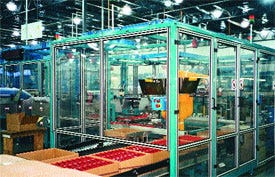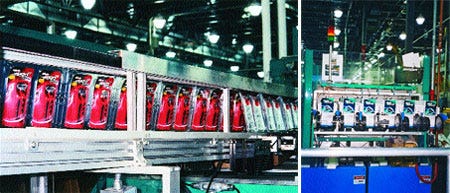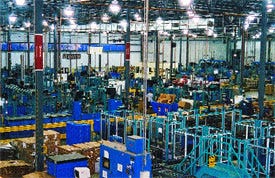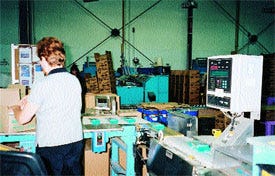Packaging on the cutting edge
January 29, 2014
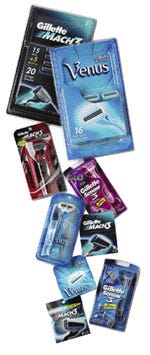
Today, as packagers face an extraordinarily difficult retail environment, with an economy that doesn't seem satisfied, they must hone their skills, retool and sometimes regroup to meet retail quality, time and inventory demands. With short or seasonal life-cycle products, a proliferation of stockkeeping units and fluctuating demand, many firms are outsourcing their packaging operations in order to eliminate complexities and costs from their supply chain. This is becoming especially true for packagers that have witnessed relatively small numbers of their base products flourish into hundreds of constantly-changing SKUs, both in terms of package configurations and "retailer/promotion-specific" graphics, that have to be "fast to market."
Packagers often run into rough stubble, trying to package their products cost effectively, efficiently and on time in this increasingly complex arena, or face costly inventory obsolescence and daunting inventory management challenges. That's why some packagers are taking a proactive approach to packaging fulfillment beyond outsourcing and copacking.
The Gillette Co., Boston, is taking just such a packaging approach. In efforts to improve customer service and responsiveness to retailers, reduce obsolescence, costs and inventories, Gillette has embarked on a new packaging path for its razors and razor blades business, called postponed packaging, that is effectively avoiding the usual close shaves with ever-changing and increasing market demands. Gillette developed and implemented the unique and successful business model by outsourcing its entire packaging function for these products to Sonoco Products Company's new Packaging Services business. The results have smoothly changed the structure and organization of those packaging functions to a cut above.
Divide and conquer
By having Sonoco Packaging Services perform the entire razor and razor blade packaging process, Gillette has been able to upgrade its own core product-manufacturing competencies as well as improve the packaging functions on a number of fronts. These include, but aren't limited to, reducing packaging materials inventory by 15 percent, improving inventory accuracy by about 10 percent, slicing labor by as much as 20 percent in its North American operations, decreasing working capital, because all of the raw packaging materials are owned by Sonoco, and thinning overall packaging costs by 15 to 20 percent within a three-year period. Postponing the packaging customization to just prior to shipping the blades and razor products to retailers, Gillette is now able to deliver orders in a week that at one time took six weeks to fill–even with promotion-specific, limited-edition or time-sensitive items.
Some of the packaging lines at the Pack Center in Devens feature fully automatic equipment, such as this robotic pick&place/loading station for razor sets.
"Consumer products companies and business-to-business companies have found that they are really managing two supply chains–their products' and their products' packaging," emphasizes Tove Rasmussen, business development manager for Sonoco's Packaging Services Group. "While packaging adds value to their products and allows them to meet retailers' expectations, packaging is not generally their core competency. We have a number of outsourcing strategies that include managing the customer's packaging operation in their facility. However, the one we employ most often through our pack centers is postponement, also known as 'pack to order.'"
Gillette basically defines packaging postponement as the delaying of the final configuration or final presentation of a retail product until very late in the production process or cycle, which improves responsiveness to retail customers and also removes costs from packaging assembly and/or package filling. By postponing the packaging process until the last possible "minute," the company says it can better avoid costly inventory obsolescence associated with potential demand forecasting changes and become more responsive to its customers.
Rasmussen points out that Sonoco's unique approach to outsourcing the packaging supply
|
Some of the packaging lines at the Pack Center in Devens feature fully automatic equipment, such as this robotic pick&place/loading station for razor sets. |
chain solutions includes managing part or all of a customer's packaging operation, the latter of which it does for Gillette. Services can range from simply packing point-of-purchase displays to creating comprehensive, customer-dedicated packaging centers, like the Gillette Pack Services Center the two companies established in Devens, MA, that transfer the complexities of the packaging supply from the customer to the separate packaging center, and subsequently established another such center with Sonoco located in Hemel, England.
Gillette leases the building and owns the equipment in the Pack Center in Devens, but the facility is managed and operated by Sonoco.
Gillette and Sonoco have been collaborating on the self-contained, self-functioning Pack Center operation in Devens for about six years, with the startup of a distribution center there. A few years later, the Pack Center was able to launch the first Gillette-branded razor pack that ever came from outside of Gillette's own factories.
The Sonoco Pack Center in Devens consolidates four of Gillette's existing North American packaging facilities into one and packs the products according to customer schedules, even during peak seasons. This has streamlined the process of meeting retailer requirements for such things as store-specific blister-packs, exclusive pack offers, certain multipack quantities and configurations, store-specific displays and promotional and/or customized structures. All of the finished product packages can be delivered exactly when the retailers need them, and not a moment too soon.
Later packaging for sooner delivery
Gillette produces more than 1.7 billion razors and blades annually for North America. This translates to some 350 package SKUs that the Pack Center produces for the North American market alone.
Why so many SKUs? The short answer, according to Gillette and Sonoco, is because that's what the market wants. Each drugstore, supermarket chain and mass merchandiser wants products to be packaged to meet their particular merchandising needs and set them apart from their competitors. This can result in many consumer products packagers occasionally spending more time on the packaging supply chain when they'd really prefer to focus on developing, marketing and manufacturing their own core products.
Says Tom Lyden, vp of manufacturing for Gillette, "At the time we developed our [new packaging postponement] strategy,
|
Blister-pack line, above, uprights sealed Mach3 Turbo Champion razor sets conveying to packer box loading and case packing stations, which, here, are automatic. Wraparound cartons, right, are readied for blade cartridges. |
Sonoco was already a packaging material supplier of ours. What led to our involving Sonoco directly in the strategy was the rapid growth we experienced in our basic operations factories. We were in the throes of launching the Mach 3 razor, had several big programs coming into our plants to support those product, and Venus [razors for women] was already out [on the market] at that time. We were confronted with a higher level of manufacturing technology for those products, so it was important to us to support the skills and competencies in those factories."
Lyden says it was becoming more apparent to Gillette that its manufacturing technologies were accelerating on a different level than its "generic" packaging operations. "It was also becoming apparent that we didn't have the flexibility we needed on the packaging end," he says. "Today, we have Pack Centers in Devens, MA, and in Hemel, England, that are looked at as having more flexibility and equipment to support that flexibility, and are more nimble in terms of workforce and workforce deployment. So as schedules go up or down by certain amounts, from week to week, month to month, we can take up much of that in the packaging operations. The postponement of the packaging comes into that by not committing a product to a finished [package] SKU until the last possible moment."
Blister-pack line, above, uprights sealed Mach3 Turbo Champion razor sets conveying to packer box loading and case packing stations, which, here, are automatic. Wraparound cartons, right, are readied for blade cartridges.
|
Equipped with 38 packaging lines, the Pack Center in Devens, MA, features a bevy of packaging functions from sophisticated, computerized blister-packing or cartoning lines to several manual lines for customized packs. |
While it sounds a bit unorthodox, both Sonoco and Gillette agree, the move to the aggressive packaging strategy and the separately managed Pack Center is working. "We've gone from a stage of having fairly significant packaging obsolescence, in terms of how goods were packaged before this strategy was in place, to almost no obsolescence today," Lyden adds. "This strategy also saves us quite a bit of labor in our basic product-manufacturing operations. We're able to be more predictive and level, in terms of the loading of those operations, because we can give responsibilities to the Pack Center, which has a flexible labor force. We've improved our product-manufacturing machine efficiencies across the board and our capabilities to run our equipment on a steady basis. Our operations are able to be very focused, and all of this has allowed us to win quite a lot of favor with retailers by being more responsive to them" [see accompanying sidebar].
Because products can be packaged sooner, and forecasting is done on a weekly basis for each SKU sooner and with higher accuracy, Rasmussen explains, products can be sped to the store shelf, boosting Gillette's ability to replenish shelves quicker and gain opportunities because products can be made and packaged sooner. "The last thing anyone wants is to be stuck with a million 12-packs of something when the retailer wants a half-million 10-packs," she says. "With postponement, when a retailer orders 10-packs, we pack 10-packs and they get 10-packs."
Leveling the load
Instead of merely putting a product in a package, the Sonoco Pack Center is engaged in a long-term relationship with Gillette to outsource all or part of Gillette's packaging supply-chain, including planning, machinery engineering and equipment specifications, as well as package filling, systems customization, materials, point-of-purchase products, graphics management, design engineering, sourcing and procurement and inventory management.
"This relationship differs from the conventional contract packager relationship," notes Charles Sullivan, vp of consumer products at Sonoco Products Co. "It goes way beyond that. We act as a packager, a materials provider and a distributor, if we can't actually supply the materials or other things from our core businesses. We have an integrated relationship [with Gillette], a more strategic relationship." The Pack Center utilizes business processes such as Six Sigma, Success and Lean Mfg., among other cutting-edge workplace organization programs to keep tabs on its side of Gillette's business.
Equipped with 38 packaging lines, the Pack Center in Devens, MA, features a bevy of packaging functions from sophisticated, computerized blister-packing or cartoning lines to several manual lines for customized packs.
"Says Sullivan, Gillette's strategy moves all of the packaging responsibilities to the Pack Center, which can provide high levels of service to retail customers from a specific package SKU standpoint," he says. "The closer we can accomplish the final packaging for Gillette, the sooner the products get to the final distribution point, which removes quite a bit of time out from the system."
Gillette's postponement relationship with Sonoco dates back to roughly 1996, based on Gillette's concepts of creating such a pack-to-order facility that Sonoco would manage on a fee-for-service basis. Sullivan explains that with the establishment of its Pack Center relationship with Gillette, Sonoco expanded its own business beyond packaging supply and created its new Packaging Services business. "We have changed our focus to include packaging services, which we have identified as a key growth driver, so it's a shift in our strategy as well. We have strategically aligned with Gillette's packaging strategy, not only relative to postponement packaging but also to supply-chain management."
This, he says, allows Gillette to leverage Sonoco's technologies, infrastructure, buying power, manufacturing expertise and more, so that Gillette can focus on what it does best: produce high-tech blades and razors teaming with breakthrough designs and performance, in eye-catching packaging that's easy to use.
In recent years, Gillette has introduced more than 20 new products annually, including the Gillette Mach3 shaving system, the Sensor3, Venus and Venus Passion for Women, which combines a breakthrough blade design surrounded by protective cushions, and the just-launched Mach3 Turbo Champion triple-blade razor and cartridge sets, the latter in bright red, raceway-themed packaging.
"There was demand for more flexibility [from our retailers] and for shorter-term responses to orders and so forth," adds Lyden. "This de-linking strategy of our razor manufacturing and packaging functions allows us to look at our basic operations factories and produce generic, finished goods that haven't been committed to a final SKU, leaving us freedom to run our [razor product] manufacturing facilities and utilize the assets in the factories apart from the market demands and shifts you'd see in a packaging operation, so that we can 'level load' the factory, as we're inclined to describe it."
Packaging lines
Based on the progress in Devens, Gillette extended its contract with Sonoco in 2000 to add the dedicated Pack Center in Hemel, England, that serves Gillette's European customers. Sonoco has also established contracts with other packagers, such as Hewlett-Packard.
PD recently visited the Pack Center in Devens, located just outside of Boston. The facility houses a 140,000-sq-ft warehouse and packaging operation, equipped with 38 packaging lines ranging from fully automatic/robotic to a combination of semi-automatic and manual or automatic and manual. The myriad of lines pack various razors and razor blade cartridges that Gillette produces in three separate manufacturing facilities in South Boston, Brazil and Mexico.
The razors and blades come in every container configuration imaginable, of course, depending on what retailers want, shipped out in combination sets, alone or in various multiples, with special promotional items and separately, in assorted types of blister-packs, paperboard folding cartons, pillow bags and thermoformed clamshells as well as seasonal packs and secondary displays.
Approximately 22 of the lines are fully automated, some of which are equipped to assemble and seal blister-packed razors using sophisticated robotic 360-deg-axis pick-and-place/feeding systems from Switzerland's Staubli AG and razor set blister-packing/RF-sealing/die-cutting systems with turnkey assembly from Automation Tooling Systems, Kiefel Technologies and England's Lambert Eng. Many lines feature Thermo Ramsey checkweighers (from Thermo Electron) and programmable logic controls from Allen-Bradley.
There are so many other systems and machines in the facility, they are too numerous to mention here, but PD was able to view some of the main lines that package razors and blade cartridge products for retail sales in one room, and others that pack the products for clubstores in another room. Four of the huge robotic packaging lines run Mach3 Turbo Champion and Venus Passion razor sets, including Lambert 56-station carousel platen razor blister-packing/sealing lines. Other groups of lines include those cartoning blade cartridges that are outfitted with high-speed Schubert systems throughout to erect, load, glue and inspect cartoned products at speeds up to 300/min. Other clusters of lines feature mixes of equipment, such as Econocorp and Hayes Machine cartoners, blister-sealing machines from Alloyd, pressure-sensitive roll labelers from Sancoa that apply security tags, baggers from Doboy for disposable razors as well as Gillette-built equipment.
Several lines have manual placement or product-feeding stations and manual component assembly stations that accommodate special packs according to what customers want. Case packaging is mostly manual but three of the larger-volume lines feature Model S-HPA-SBD-SA case sealers from Marq Packaging Systems.
John Pescatore, program manager for the North American Packaging Center, says most of the existing packaging equipment was brought to the Pack Center from the former Gillette packaging operations, though some new equipment has been installed, such as systems for new razor brands such the Venus razor for Women. The center's workforce comprises 750 employees–60 percent of which are full-time and 40 percent flexible time.
In general, most of the lines are dedicated to particular types of "core packages," explains site general manager Gerson Heiderich. "These can be changed over maybe five to ten times a week, others maybe once a week. And some lines can be changed ten to twenty times to accommodate different brands of product. We have to plan the changes around machine uptime and try to keep the changes to a minimum."
Right package for the product
"As we moved Gillette's packaging processes here to the Pack Center, [the] Venus [brand of products] was really the first major program in which the packaging was done on the outside of our managed facilities," Pescatore notes. "With the Pack Center being able to respond so quickly to all kinds of requests, orders, and everything else, Gillette can reduce its own inventory to the point where it's making products to-order, just as the Sonoco Pack Center is packaging those products to-order. That's the perfect scenario, and we're almost there.
We have a very good idea as to what our numbers are going to be in terms of what we'll sell in blades and razors," Pescatore continues. "What we don't know is what packaging we're going to sell them in, because our customers really aren't loyal to our packages–they're loyal to our products. What this packaging strategy and business model are designed to do, and are in fact doing, is putting the product in the right package. We're better able to avoid having too much product in, say, a twenty-pack, and not enough in four-packs, so we can have the right items in the warehouse when the order comes in."
How fast to flex?
And indeed, orders come in. Upon reaching the center's packaging floor, which occupies about 183,000 sq ft, one first approaches a 130,650-sq-ft warehouse that holds mostly Gillette's finished products or what it calls FWIP, Finished Work in Progress–in some 15,000 locations in about 30 aisles. There, radio-frequency-coded pallet loads are arranged according to a wide mix of processes and products. The loads can be stacked in five-high racks, with warehouse management updating all schedules, not only on a daily basis but on a cyclic basis, Heiderich says.
"Everything in the center is configured for optimal traffic, cost reduction, elimination of downtime and increased output, among other considerations," Heiderich says, adding that there are far more particulars, but basically, each line's levels and performance are measured every shift. "We also review operation and performance each shift and conduct weekly performance reviews, so this strategy requires changing the manufacturing mindset. That's difficult. It's not a question of becoming flexible, it's asking how flexible can we be and how fast can we flex?" Heiderich says the operation generally runs three 8-hr shifts a day, five days a week, but since shift schedules can vary, the Pack Center can operate on an unconventional basis. The lines run anywhere from 50 to 300 packs/min, depending on what's being packed and what quantities and volumes are required. "The key here is quality," he says. "Line speeds all vary, and the number of people online all vary, depending upon the SKU. We do what it takes to improve scheduling adherence performance and customer service."
Schedules dictate how many line workers will be needed from shift to shift, day to day. "One line here might be running today, but may not be needed tomorrow," Heiderich adds. Another of Sonoco's roles, he says, is to develop packaging-related competencies operating in the flexible environment. "All of this requires tremendous discipline," he points out. "There must be extremely close communication and contact between Sonoco and Gillette, and it requires mastering the management of a temporary workforce."
Blister, cartoning lines
The FWIP razor or blade products (unpackaged razors and blade cartridges and cartridge sets) are brought through order picking from the warehouse to the packaging room floor. On the day PD visited, a group of five packaging lines was focused on wraparound cartoning of such products as Gillette Good News! disposable razors in five-packs while another cluster was cartoning various blade cartridge brands. Display units, additional promotional items and shipping case configurations for these products is highly customer-specific.
|
Many packaging functions are manual, such as palletizing, some case packing and product placement and feeding, accomplished by a flexible workforce. |
Most of the main packaging functions on the packaging floor are automated, except for functions like feeding, placing and retrieving and quality and visual inspection, Heiderich notes.
"Palletizing is done manually throughout the plant," he informs PD. "We can't yet justify the investment. If we ran all of these lines five days a week, flat out, twenty-four hours a day, we could justify the investment, but again, demand flexes for certain products. We can go from high to low demand and back to high demand quickly, so we don't always need automatic equipment."
Sonoco supplies much of the wraparound folding carton stock and kraft blister-cards for many of the packages, which are furnished through its folding carton plants. But it doesn't necessarily supply all of those materials all of the time, Heiderich tells PD. There are various packaging materials suppliers.
Depending on the run, anywhere from six to eight people can be put into service, or more if volumes demand it, Heiderich says. "These lines basically are equipped to perform similar types of packaging functions, such as cartoning, blister-pack sealing and so on. However, they are not dedicated," he notes.
Many packaging functions are manual, such as palletizing, some case packing and product placement and feeding, accomplished by a flexible workforce.
The new, bright red Mach3 Champion Turbo triple-blade razor and the Venus Passion were also being packaged during the plant visit, in sets with blade cartridges in clear PVC blister-packs with colorful paperboard card inserts on some of the newest robotic subassembly and razor blister-packing lines that utilize the Staubli robots to unload and reload trays, before the individual blister packs are are sealed in custom blisters (many of which are supplied by Placon and Innovative Plastics Corp.). The packs were then checkweighed online by the Thermo Electron/Ramsey Icore systems, ensuring that all assembled components were securely fitted inside the packaging.
These are but a few examples of the numerous packaging activities that can take place each day in the Pack Center.
Cutting-edge strategy
Because labor costs are reduced with the combination of a full-time and flex-time workforce, the Pack Center says it can quickly ramp up or down with weekly fluctuations. Has Gillette reached its goals or is it meeting them? Lyden says there's no question about it. "We've avoided plant expansion, we have a focused factory workforce, we're winning favor with retailers by being so responsive and we're seeing the results from that. Service levels are way up from where they were at one point in time and our costs are down because of that. Step by step, as we go along, we want to explore ways to leverage this kind of relationship [we have with Sonoco] to the next level. Things have turned out well. In the future, we'll look to see if there are other things Sonoco can do along the same theme of postponement in certain [of our other] basic operation factories."
More information is available:
Packaging services center, packaging components, folding cartons, blister cards, supplies, services:Sonoco Products Co./Sonoco Packaging Services, 843/383-7794. Circle No. 233.
Robotics: Staubli Corp. North America, Robotics Div., 864/433-1980. Circle No. 234.
Blister-pack assembly equipment: Automation Tooling Systems, 519/653-6500. Circle No. 235.
Case packing, sealing equipment: Marq Packaging Systems, Inc., 509/966-4300. Circle No. 236.
Blister-packing/RF sealing/die-cutting: Kiefel Technologies, 603/929-3900. Circle No. 237.
Carousel blister packing/sealing: Lambert Engineering Ltd., 44 0 1937 832921. Circle No. 238.
Blister sealers: Alloyd Co., Inc., 815/756-8451. Circle No. 239.
Blisters: Innovative Plastics Corp., 845/359-7500. Circle No. 240.
Blisters: Placon Corp., 608/271-5634. Circle No. 241.
Cartoners: Econocorp, Inc., 781/986-7500. Circle No. 242.
Cartoners: Hayes Machine Co., Inc., 800/860-6224. Circle No. 243.
Labelers: Sancoa Intl., 856/273-0700. Circle No. 244.
Cartoning lines: Schubert Packaging Systems LLC, 972/233-6665. Circle No. 245.
Bagging systems: Doboy Div., SIG Pack, Inc., 715/246-6511. Circle No. 246.
Checkweighers: Thermo Electron Corp., Weighing and Inspection Div., 763/783-2500. Circle No. 247.
Controls: Allen-Bradley Co., 440/646-3276. Circle No. 248.
Postponement pays with Supplier Award |
Among the many dividends Gillette enjoys as a result of its and Sonoco's new packaging efforts, Gillette indicates that customers, including mega-retailer Wal-Mart Inc., are quite pleased with their shipments, in terms of on-time delivery, content quality, accuracy and consistency. In 2002, Wal-Mart awarded Gillette's entire health and beauty aids department with its Supplier of the Year Award, in part Gillette/Sonoco folks say, due to the new Pack Center's performance. Considered by Gillette to be an "unprecedented achievement," the award is Wal-Mart's highest supplier honor. To win, a package supplier must: |
About the Author(s)
You May Also Like
